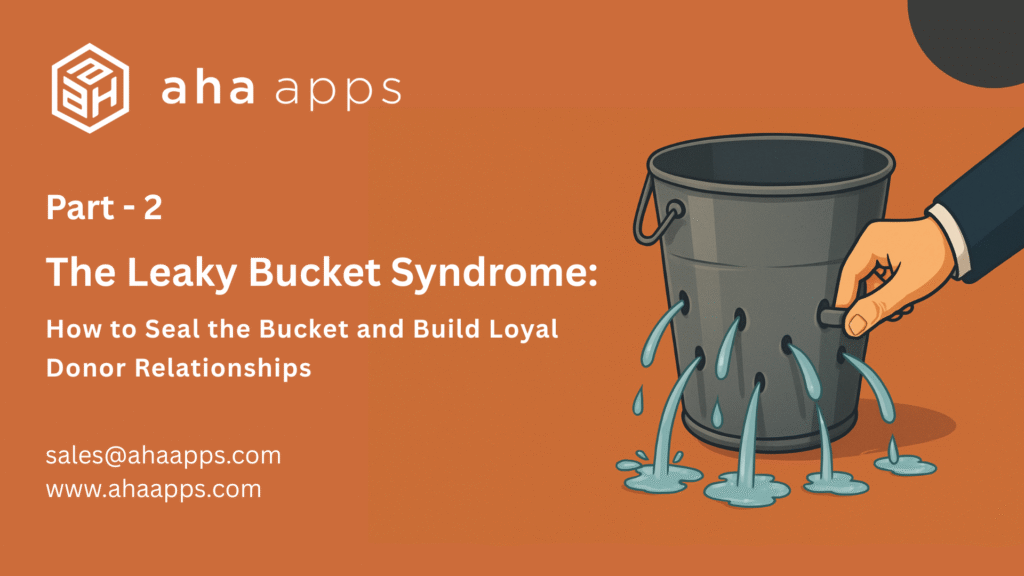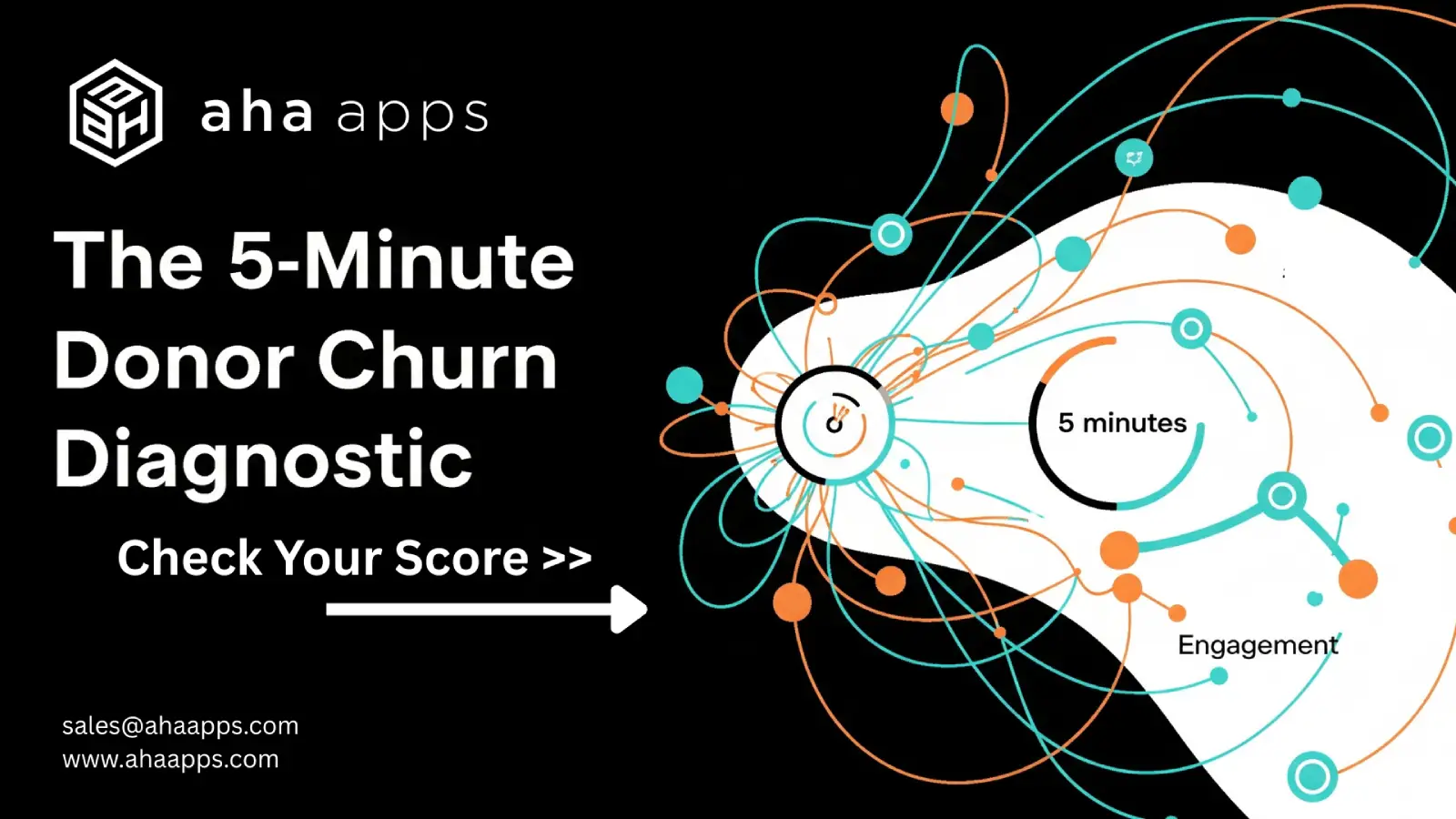Sep 29th, 2025
By Satish Reddy | Reading time 5 mins
The Leaky Bucket Syndrome: How to Seal the Bucket and Build Loyal Donor Relationships – Part 2
Welcome back. In Part 1, we diagnosed the “Leaky Bucket Syndrome”—the alarming fact that nearly 70% of first-time donors never give again—and identified outdated systems and impersonal communication as the primary culprits. The good news is that this problem is entirely solvable.
Now, it’s time to roll up our sleeves and get practical. Here is your five-step plan to fix the leaks, stop the donor drain, and build a thriving community of loyal supporters using a modern CRM like Aha Impact, powered by Microsoft Dynamics.

Take The 5-Minute Donor Churn Diagnostic.

Step 1: Build a Personal Connection with a 360-Degree View
You can’t build a relationship with a stranger. The foundation of donor loyalty is knowing who your supporters are beyond their first transaction. A modern CRM creates a unified donor profile, serving as your single source of truth. It consolidates every touchpoint—donations, event attendance, volunteer hours, email clicks, and personal notes—into one comprehensive record.
Aha Impact provides this complete view, allowing you to see a donor’s total giving history, event participation, and volunteer activities in one place. This empowers you to move from generic communication to genuine connection.
- Instead of: “Dear Supporter,”
- Try: “Hi Michael, thank you again for your first gift during our Giving Tuesday campaign. We were so glad you could also volunteer at our annual food drive last month!”
This level of personalization shows you’re paying attention. It tells the donor they are a valued member of your community, not just a line in a spreadsheet.
Step 2: Automate Without Losing the Human Touch
One of the biggest challenges for nonprofits is the sheer lack of time and resources. This is where smart automation becomes your most valuable ally. Automation isn’t about being robotic; it’s about being consistently human at scale.
With a powerful CRM, you can design automated workflows that nurture relationships from day one:
- The New Donor Welcome Series: The moment a first-time donation is made, automatically enroll the donor in a 30-day email journey. Week 1: A personalized thank you video from your Executive Director. Week 2: A powerful story of impact made possible by their gift. Week 3: An invitation to follow you on social media. This builds a connection long before a second ask is ever made.
- Intelligent Task Creation: Aha Impact’s reporting can instantly flag donors who gave last year but not this year (LYBUNT). A smart workflow can automatically create a task for a development officer to make a personal phone call to these high-value individuals.
Donor Journey Tracking: Our system allows you to track the precise stage of each donor’s relationship from initial solicitation to acknowledgment and long-term stewardship. This ensures no one falls through the cracks.
Step 3: Measure What Matters to Drive Growth
To fix a leak, you must first measure where the water is going. Intuition is no longer enough; you need data-driven insights. A modern CRM provides clear, visual dashboards and analytics that transform data into action.
The Aha Impact dashboard gives you a real-time view of your fundraising health, showing top donors by lifetime giving, high-revenue events, and donation trends over time.
This helps you answer critical strategic questions:
- Which fundraising campaigns attract donors with the highest lifetime value?
- What is the average time between a donor’s first and second gift?
- Which communication channels are most effective for different donor segments?
This empowers you to shift from a reactive fundraising posture to a proactive, data-informed strategy.
Step 4: Launch Retention Campaigns That Actually Work
Armed with deep insights from your CRM, you can run highly targeted retention campaigns. For example, market research shows that people who volunteer for your cause are highly likely to donate, but are often overlooked.
With Aha Impact’s advanced search function, you can easily build a list of every volunteer who has not yet made a financial gift. Then, you can launch a specific, multi-channel campaign just for them. The message is incredibly powerful: “We have seen your passion and commitment through the hours you’ve volunteered. Your time is the most valuable gift, and a donation of any amount will help amplify the impact of your work.” This is a message that resonates because it’s personal, acknowledges their existing contribution, and is built on data you can only get from an integrated CRM.
Step 5: Close the Loop with Impact Reporting
Donors leave when they don’t feel their contribution made a difference. The final step in sealing your leaky bucket is to relentlessly show them their impact. Use your CRM to segment donors who gave to a specific campaign and send them a follow-up impact report.
This can be automated. Three months after your “Spring Education Drive,” your CRM can send a personalized email to every donor who contributed, complete with photos and a simple message: “Because of your gift, 35 local students received the tutoring they needed to graduate. Thank you for making this possible.” This simple act closes the loop and is one of the most powerful drivers of donor loyalty.
Stop Patching Leaks. Rebuild the Bucket.
Your mission is too important to be held back by inefficient systems. Stop pouring your team’s precious time, energy, and resources into a leaky fundraising bucket. It’s time to fix the holes for good with Aha Impact, the CRM solution built on Microsoft Dynamics and tailored for you.
Ready to see how an integrated CRM can transform your fundraising? You have two ways to get started.
Schedule a no-obligation session with our nonprofit experts. We’ll help you diagnose your specific retention challenges and build a roadmap for sustainable growth.
Why 70% of Your First-Time Donors Never Return—And How to Fix It
Part 1 uncovers the hidden dangers of The Leaky Bucket Syndrome and why most new donors never come back. Discover what’s really causing the drop-off—and why outdated systems might be quietly sabotaging your fundraising efforts.